

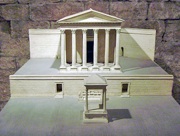
The French archaeologist Charles Victor Famin carried out the first excavations here in 1836. His work revealed the original pavement (early 1st century BC) of the Roman forum some 5 metres below the Piazza del Comune and allowed the reconstruction of the original setting of the so-called Temple of Minerva. The excavated area can be visited from the Museo Civico.
Retaining Wall under the Temple ‘of Minerva’
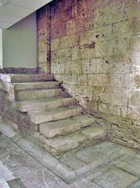
The retaining wall continues beyond the Temple, although the style of its construction changes: the stone blocks in this less prestigious location become smaller and less regular. This part of the wall was probably used for the display of laws and decrees promulgated by the government of the municipium.
Inscription [22]
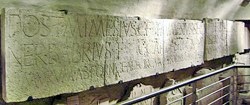
The long inscription (CIL XI 8021) here, which the EAGLE database (see this CIL link) dates to the period 89-40 BC, originally referred to the men responsible for the building or restoration of this retaining wall:
-
✴the two quattuorviri iure dicundo, whose names have been lost;
-
✴the quinqueviri (the members of a college of five magistrates or priests):
-
•C(aius) Babrius Chilo, son of C(aius);
-
•C(aius) Veistinius Capito, son of C(aius);
-
•C(aius) Vallius, son of C(aius);
-
•L(ucius) Visellius, son of L(ucius); and
-
•Cn(aeus) Veistinius, son of Cn(aeus); and
-
✴C(aius) Attius Clarus, son of T(itus), who paid for the stucco decoration of the wall.
Tribune
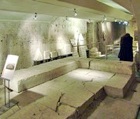
Pavement Inscription [23]
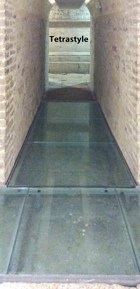
-
✴the quattuorviri iure dicundo:
-
•C(aius) Caetronius, son of C(aius); and
-
•C(aius) Attius Ruf(ius), son of C(aius); and
-
✴two other men whose magistracy was probably recorded on the stones now under the tetrastyle:
-
•T(itus) Olius Gargenna, son of C(aius); and
-
•L(ucius) Ca[..]tius B....., son of C(aius).
Scholars generally assume that these last two men were two of the serving quinqueviri: thus Enrico Zuddas (referenced below, at p. 238) suggested that:
-
“... the names of another three[quinqueviri] and a final formula of the type ‘senatus consulto faciundum coiravere’ were [probably] obliterated by the tetrastyle that was built above” (my translation).
Enrico Zuddas (referenced below, at p. 357) suggested that the family name of the quinquevir L(ucius) Ca[..]tius B....., son of C(aius) could have been Caelius, Callus or Cattius.
Enrico Zuddas (referenced below, at pp. 359-60) described another block that was found in 1969 near the steps to the left that led up to the pronaus of the temple, with evidence of an inscription (EDR 028688) that can be restored as:
[... ]ca Cn(aeus) Fuficius [....].
He suggested that this block could have been the 14th in the series described here. In that case:
-
✴L(ucius) Ca[..]tius B....., (above) might have been L(ucius) Ca[..]tius B..... [Pert ?]ica; and
-
✴ Cn(aeus) Fuficius [....] would have been a third quinquevir. He could have been (or been the father of) Cnaeus Fuficius Laevinus, son of Cnaeus, recorded as quattuorviri iure dicundo in CIL XI 5391-2.
3rd Inscription Recording Quinqueviri (ca. 30-1 BC) [25]
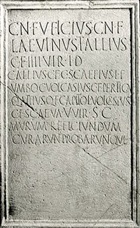
-
✴the quattuorviri iure dicundo:
-
•Cnaeus Fuficius Laevinus, son of Cnaeus; and
-
•Titus Allius, son of Caius; and
-
✴the quinqueviri:
-
•[Caius] Allius, son of Caius;
-
•Caius Scaefius Umbo, son of Lucius;
-
•Caius Volcasius Pertica, son of Caius;
-
•Quintus Attius Capito, son of Quintus; and
-
•Lucius Volcasius Scaeva, son of Caius.
This inscription is now in the Museo Civico and is also discussed in that page.
Another inscription (CIL XI 5391), which is identical except that the names of the quattuorviri are reversed, was found outside Bettona and is now embedded in the entrance wall of the Palazzo del Podestà there. Although it is possible that one or both of these refer to a restoration of the walls of Bettona, it is much more likely (given the form of the magistracy) that they both came from Assisi.
Tetrastyle
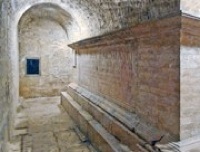
The large rectangular structure at the end of the passage formed the base of a four-columned tabernacle or tetrastyle (1st century AD) that stood in front of the temple and coincident with its axis. (as shown in the reconstruction at the top of the page).
Inscription [4]
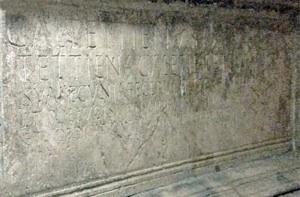
The surviving inscription (CIL XI 5372) on the rear of the base, which the EAGLE database (see this CIL link) dates to the period 14-68 AD, reveals that the tetrastyle above housed statues of Castor and Pollux. It records the names the donors as:
-
✴Galeo Tettienus Pardalas; and
-
✴his wife (or mother) Tettiena Galene;
and says that they distributed money at the dedicatory festival:
-
✴5 denari to each decurione;
-
✴3 denari to each of the seviri (the members of a college of six magistrates); and
-
✴a denarius to each of the plebs.
Gian Luca Gregori (referenced below, at p. 972) suggested that Galeo Tettienus Pardalas and his wife were freed slaves of Galeo Tettienus, the husband of Petronia (who was recorded in relation to the amphitheatre of Asisium two inscriptions - CIL XI 5406 and CIL XI 5432 - in the Museo Civico, both of which date to the 1st half of the 1st century AD)
West Part of the Excavated Area
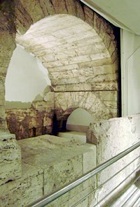
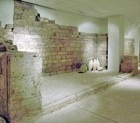
Read more:
E. Zuddas, “Asisium: Aggiunte e Correzioni ai Monumenti Epigrafici Compresi nelle Raccolte che si Aggiornano”, Supplementa Italica, 23 (2007) 268-347
G. L. Gregori, “Amphitheatralia I”, Mélanges de l' École Française de Rome, 96 (1984) 961-85
Return to Museo Civico.
Return to Walk I.
Return to the home page on Assisi.

